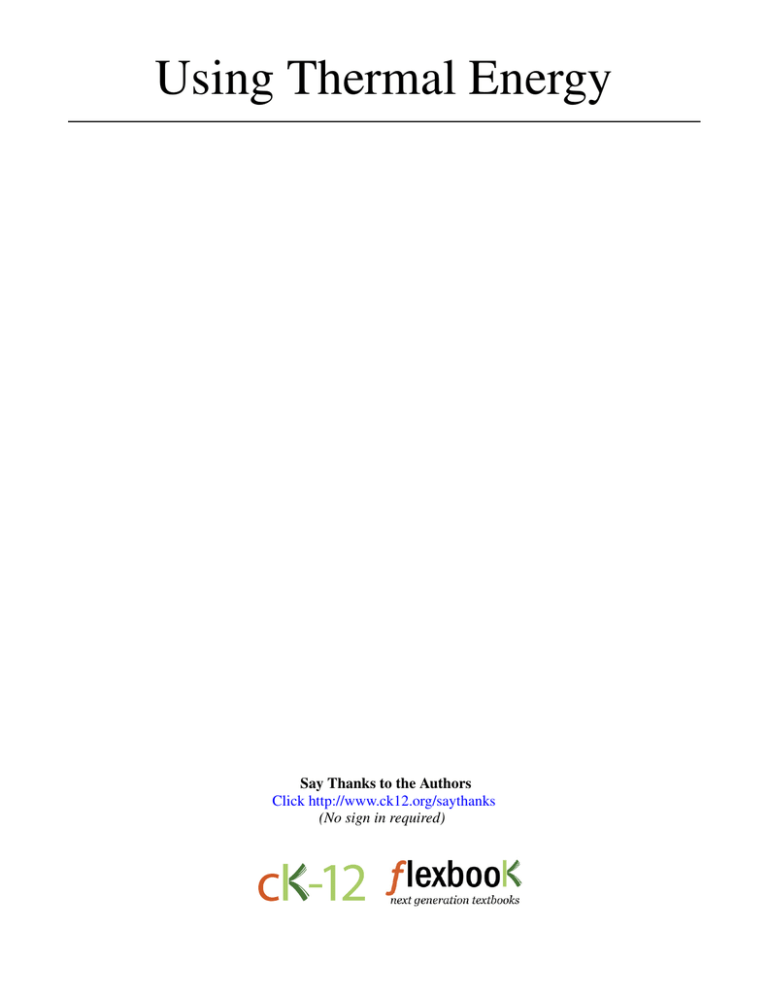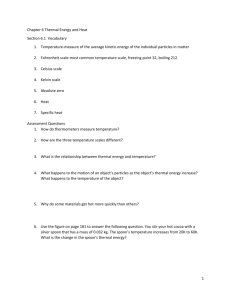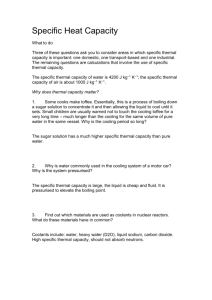Using Thermal Energy Say Thanks to the Authors (No sign in required) Click
advertisement

Using Thermal Energy Say Thanks to the Authors Click http://www.ck12.org/saythanks (No sign in required) To access a customizable version of this book, as well as other interactive content, visit www.ck12.org CK-12 Foundation is a non-profit organization with a mission to reduce the cost of textbook materials for the K-12 market both in the U.S. and worldwide. Using an open-content, web-based collaborative model termed the FlexBook®, CK-12 intends to pioneer the generation and distribution of high-quality educational content that will serve both as core text as well as provide an adaptive environment for learning, powered through the FlexBook Platform®. Copyright © 2014 CK-12 Foundation, www.ck12.org The names “CK-12” and “CK12” and associated logos and the terms “FlexBook®” and “FlexBook Platform®” (collectively “CK-12 Marks”) are trademarks and service marks of CK-12 Foundation and are protected by federal, state, and international laws. Any form of reproduction of this book in any format or medium, in whole or in sections must include the referral attribution link http://www.ck12.org/saythanks (placed in a visible location) in addition to the following terms. Except as otherwise noted, all CK-12 Content (including CK-12 Curriculum Material) is made available to Users in accordance with the Creative Commons Attribution-Non-Commercial 3.0 Unported (CC BY-NC 3.0) License (http://creativecommons.org/ licenses/by-nc/3.0/), as amended and updated by Creative Commons from time to time (the “CC License”), which is incorporated herein by this reference. Complete terms can be found at http://www.ck12.org/terms. Printed: November 10, 2014 www.ck12.org C HAPTER Chapter 1. Using Thermal Energy 1 Using Thermal Energy Lesson 18.3: True or False Name___________________ Class______________ Date__________ Determine if the following statements are true or false. _____ 1. The function of a thermostat is to transfer thermal energy. _____ 2. The water in a hot-water heating system is heated by a furnace. _____ 3. In a warm-air heating system, pipes carry thermal energy throughout the house. _____ 4. Thermal energy from inside a refrigerator changes the refrigerant to a gas. _____ 5. A combustion engine burns fuel to produce thermal energy. _____ 6. In any combustion engine, the engine does the work of moving a piston. _____ 7. In a warm-air heating system, warm-air vents are always placed near the ceiling. _____ 8. An air conditioner is an example of a cooling system. _____ 9. Refrigerant changes to a liquid in the condenser of a refrigerator. _____ 10. Steam ships have internal combustion engines. Lesson 18.3: Critical Reading Name___________________ Class______________ Date__________ Read this passage from the text and answer the questions that follow. Cooling Systems Cooling systems, such as air conditioners and refrigerators, transfer thermal energy in order to keep homes and cars cool or to keep food cold. In a refrigerator, for example, thermal energy is transferred from the cool air inside the refrigerator to the warmer air in the kitchen. Thermal energy naturally moves from a warmer area to a cooler area, so how can it move from the cooler refrigerator to the warmer room? The answer is work. The refrigerator does work to transfer thermal energy in this way. Doing this work takes energy, which is usually provided by electricity. The key to how a refrigerator (or other cooling system) works is the refrigerant. A refrigerant is a substance, such as FreonT M , that has a low boiling point and changes back and forth between liquid and gaseous states as it cycles through the refrigerator. As a liquid, the refrigerant absorbs thermal energy from the cool air inside the refrigerator. The thermal energy causes the refrigerant to change to a gas. As a gas, the refrigerant releases thermal energy to the warm air outside the refrigerator. This causes the refrigerant to change back to a liquid, and the cycle repeats. Questions 1. What is a cooling system? 2. What work must a cooling system do? 3. What is the role of the refrigerant in a cooling system? 1 www.ck12.org Lesson 18.3: Multiple Choice Name___________________ Class______________ Date__________ Circle the letter of the correct choice. 1. Types of home heating systems include a. b. c. d. warm-air heating systems. hot-water heating systems. solar heating systems. all of the above 2. How is thermal energy transferred in a refrigerator? a. b. c. d. from the warm kitchen to the cool refrigerator from the cool refrigerator to the warm kitchen from the cool refrigerator to the cold outdoors two of the above 3. Why must a cooling system do work to keep things cool? a. b. c. d. It transfers thermal energy from a cooler to a warmer place. It takes energy to reverse the normal direction of heat flow. It takes energy to maintain the normal direction of heat flow. two of the above 4. What happens to the refrigerant as it passes through a cooling system? a. b. c. d. It freezes and lowers the temperature of the system. It changes between liquid and gaseous states. It releases thermal energy into the refrigerator. It keeps evaporating and has to be replaced. 5. In an external combustion engine, thermal energy is used directly to a. b. c. d. move the piston back and forth. move the piston up and down. turn water into steam. all of the above 6. What happens first in an internal combustion engine? a. b. c. d. Exhaust gases exit the cylinder. The piston moves up or down. A fuel-air mixture enters the cylinder. The piston rod turns the crankshaft. 7. Thermal energy from a radiator travels throughout the air in a room by a. b. c. d. conduction. convection. radiation. all of the above Lesson 18.3: Matching Name___________________ Class______________ Date________ 2 www.ck12.org Chapter 1. Using Thermal Energy Match each definition with the correct term. Definitions _____ 1. substance that absorbs and releases thermal energy in a cooling system _____ 2. device in a heating system that controls the furnace or boiler _____ 3. complex machine that produces thermal energy outside the machine and uses the thermal energy to do work _____ 4. heating system that includes a boiler, pipes, and radiators _____ 5. complex machine that produces thermal energy inside the machine and uses the thermal energy to do work _____ 6. refrigerator or air conditioner _____ 7. heating system that includes a furnace, ducts, and vents Terms a. internal combustion engine b. cooling system c. refrigerant d. warm-air heating system e. external combustion engine f. hot-water heating system g. thermostat Lesson 18.3: Fill in the Blank Name___________________ Class______________ Date________ Fill in the blank with the appropriate term. 1. As hot water flows through the pipes and radiators of a hot-water heating system, the water becomes __________. 2. Vents are placed near the floor in a warm-air heating system because warm air is low in density and __________. 3. A cooling system transfers thermal energy from a cooler area to a warmer area by doing __________. 4. The key to how a cooling system works is a substance with a low boiling point called a(n) __________. 5. Any complex machine that burns fuel to produce thermal energy and then uses the energy to do work is a(n) __________. 6. The type of engine that is found in most motor vehicles is a(n) __________ combustion engine. 7. A steam engine is a type of engine called a(n) __________ combustion engine. Lesson 18.3: Critical Writing Name___________________ Class______________ Date________ Thoroughly answer the question below. Use appropriate academic vocabulary and clear and complete sentences. Explain how an external combustion engine produces thermal energy and uses it to do work. 3






